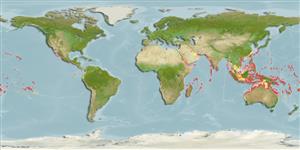Common names from other countries
>
Eupercaria/misc (Various families in series Eupercaria) >
Labridae (Wrasses) > Corinae
Etymology: Thalassoma: Greek, thalassa = the sea + Greek, soma = body; the colour of the sea (Ref. 45335).
More on authors: Lay & Bennett.
Environment: milieu / climate zone / depth range / distribution range
นิเวศวิทยา
เกี่ยวกับทะเล,น้ำเค็ม เกี่ยวกับหินโสโครก; ระดับความลึก 0 - 40 m (Ref. 2334), usually 1 - 5 m (Ref. 90102). Tropical; 30°N - 32°S
Indo-Pacific: East Africa to the Hawaiian, Marquesan, and Tuamoto islands, north to the Ryukyu Islands. Replaced by Thalassoma cupido from southern Japan to Taiwan, Thalassoma heiseri in Pitcairn, and Thalassoma loxum at Oman (Ref. 37816). Reported hybrids with Thalassoma jansenii in Banda Sea, Indonesia and with Thalassoma nigrofasciatum in Holmes Reef, Coral Sea (Ref. 57554).
ขนาด / น้ำหนัก / Age
Maturity: Lm ? range ? - ? cm
Max length : 17.0 cm TL เพศผู้/กระเทย; (Ref. 4392)
เงี่ยงครีบหลัง (รวม) : 8; ก้านครีบอ่อนที่หาง (รวม) : 12 - 14; เงี่ยงครีบก้น: 3; ก้านครีบอ่อนที่ก้น: 10 - 12. Males display with brilliant colors, red lines turning purple and often the abdomen bright yellow (Ref. 48636). Two uneven red stripes on dorsal half of body, 1 from below dorsal-fin origin onto upper caudal lobe, the other from above pectoral-fin base to caudal peduncle. Pectoral fins with green base and dark pectoral fins (Ref 9823).
Found in clear outer lagoon reefs (Ref. 9710) and exposed seaward reefs. Abundant in shallow exposed areas with surge channels (Ref. 9710, 48636), with gutters, large Acropora plates and algae bottom (Ref. 48636). Benthopelagic (Ref. 58302). Males are often in small loose numbers, swimming over reef sections where small groups of females stay close to the bottom. Juveniles secretive in shallow gutters (Ref. 48636). Feed mainly on benthic crustaceans (crabs, shrimps), small fishes, gastropod mollusks, and sea urchins.
Life cycle and mating behavior
Maturities | การสืบพันธุ์ | Spawnings | Egg(s) | Fecundities | ตัวอ่อน
Pelagic spawner.
Randall, J.E., G.R. Allen and R.C. Steene, 1990. Fishes of the Great Barrier Reef and Coral Sea. University of Hawaii Press, Honolulu, Hawaii. 506 p. (Ref. 2334)
IUCN Red List Status (Ref. 130435)
CITES (Ref. 128078)
Not Evaluated
Threat to humans
Harmless
Human uses
การประมง: การค้า; สถานที่แสดงสัตว์และพืชน้ำ: การค้า
เครื่องมือ
Special reports
Download XML
แหล่งที่มาจากอินเตอร์เน็ต
Estimates based on models
Preferred temperature (Ref.
115969): 25 - 29.3, mean 28.3 (based on 2873 cells).
Phylogenetic diversity index (Ref.
82804): PD
50 = 0.5000 [Uniqueness, from 0.5 = low to 2.0 = high].
Bayesian length-weight: a=0.00955 (0.00430 - 0.02123), b=3.06 (2.89 - 3.23), in cm Total Length, based on LWR estimates for this Genus-body shape (Ref.
93245).
ระดับชั้นอาหาร (Ref.
69278): 3.6 ±0.56 se; based on food items.
ความสามารถในการกลับคืนสู่ปกติ (Ref.
120179): ความสูง, เวลาต่ำสุดที่จะทำให้ประชากรเพิ่มขึ้นเป็น 2 เท่าใช้เวลาน้อยกว่า 15 เดือน (Preliminary K or Fecundity.).
Fishing Vulnerability (Ref.
59153): Low vulnerability (10 of 100).
